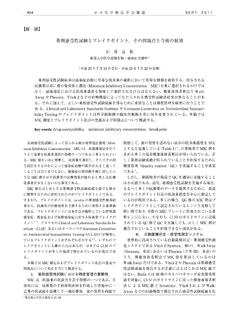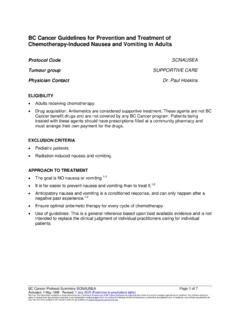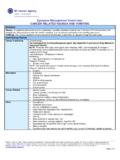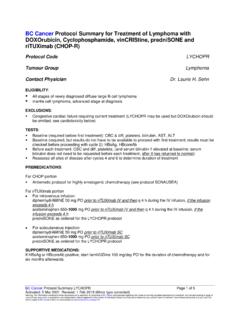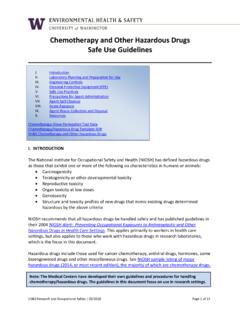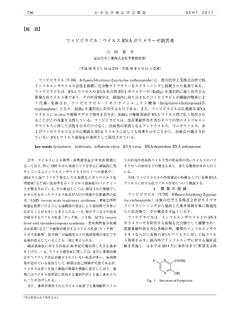Transcription of BC Cancer Protocol Summary for Palliative Combination ...
1 BC Cancer Protocol Summary GIFIRINOX Page 1 of 10 Activated: 1 Jun 2011 Revised: 1 Oct 2021 (ST chair name, contact information, Eligibility and Cautions updated) Warning: The information contained in these documents are a statement of consensus of BC Cancer professionals regarding their views of currently accepted approaches to treatment. Any clinician seeking to apply or consult these documents is expected to use independent medical judgement in the context of individual clinical circumstances to determine any patient's care or treatment.
2 Use of these documents is at your own risk and is subject to BC Cancer 's terms of use available at BC Cancer Protocol Summary for Palliative Combination chemotherapy for Advanced Pancreatic Adenocarcinoma Using Irinotecan, Oxaliplatin, Fluorouracil and Leucovorin Protocol Code: GIFIRINOX Tumour Group: Gastrointestinal Contact Physician: GI Systemic Therapy ELIGIBILITY: First line therapy for locally advanced or metastatic pancreatic adenocarcinoma. ECOG performance status less than or equal to 1 Patients who have received single agent capecitabine or fluorouracil treatment first-line as the result of frailty, but who are now well enough to receive Combination chemotherapy .
3 Patients who have progressed on single agent capecitabine or fluorouracil therapy first-line and treatment escalation/ Combination chemotherapy is desired. Patients cannot receive both GIFIRINOX and GIPGEMABR sequentially. A BC Cancer Compassionate Access Program (CAP) approval is required prior to starting the second Protocol if patients are intolerant to the first Protocol ordered. EXCLUSIONS: Ampullary Cancer CNS metastases Suspected dihydropyrimidine dehydrogenase (DPD) deficiency (see Precautions) Avoid in patients with congenital long QT syndrome.
4 CAUTIONS: Adequate marrow reserve, renal and liver function Patients with: 1) previous pelvic radiotherapy; 2) recent MI; 3) uncontrolled angina, hypertension, cardiac arrhythmias, congestive heart failure or other serious medical illness Patients with baseline greater than 3 loose BM per day (in patients without colostomy or ileostomy) Patients with symptomatic peripheral neuropathy Patients over 75 years of age Patients with baseline hyperbilirubinemia (greater than 26 micromol/L) not explained by degree of liver metastases TESTS AND MONITORING.
5 Baseline CBC and differential, platelets, creatinine, LFTs (bilirubin, ALT, alkaline phosphatase), sodium, potassium, magnesium, calcium, appropriate imaging study and optional CEA, CA 19-9. At the beginning of each cycle: CBC and differential, platelets, creatinine, LFT s (bilirubin, ALT, alkaline phosphatase), sodium, potassium, magnesium, calcium If clinically indicated: CEA, CA 19-9 For patients on warfarin, weekly INR during fluorouracil therapy until stable warfarin dose established, then INR at beginning of each cycle.
6 Baseline and routine ECG for patients at risk of developing QT prolongation (at the discretion of the ordering physician). See Precautions. Patients to be seen by physician at every cycle (every 2 weeks) Quantitative evaluation of disease response status every six to 10 weeks; discontinue therapy if any progression of disease. BC Cancer Protocol Summary GIFIRINOX Page 2 of 10 Activated: 1 Jun 2011 Revised: 1 Oct 2021 (ST chair name, contact information, Eligibility and Cautions updated) Warning: The information contained in these documents are a statement of consensus of BC Cancer professionals regarding their views of currently accepted approaches to treatment.
7 Any clinician seeking to apply or consult these documents is expected to use independent medical judgement in the context of individual clinical circumstances to determine any patient's care or treatment. Use of these documents is at your own risk and is subject to BC Cancer 's terms of use available at PREMEDICATIONS: Antiemetic Protocol for highly emetogenic chemotherapy (see SCNAUSEA) Atropine may be required for treatment or prophylaxis of diarrhea (see precautions) Prochlorperazine should be avoided on the same day as irinotecan treatment due to the increased incidence of akathisia.
8 Counsel patients to avoid cold drinks and exposure to cold air, especially for 3-5 days following oxaliplatin administration. Cryotherapy (ice chips) should NOT be used as may exacerbate Oxaliplatin-induced pharyngo-laryngeal dysesthesias. TREATMENT: A cycle equals: Drug Dose BC Cancer Administration Guidelines oxaliplatin* 85 mg/m2 IV in 250 to 500 mL of D5W over 2 hours immediately followed by leucovorin 400 mg/m2 IV in 250 mL D5W over 1 hour 30 minutes irinotecan 180 mg/m2 IV in 500 mL of D5W over 1 hour 30 minutes** Immediately followed by fluorouracil 400 mg/m2 IV push, followed by fluorouracil 2400 mg/m2 IV over 46 h in D5W to a total volume of 230 mL by continuous infusion at 5 mL/h via Baxter LV5 INFUSOR ** Repeat every 14 days until disease progression.
9 * Oxaliplatin is not compatible with normal saline. Do not piggyback or flush lines with normal saline. ** Irinotecan and leucovorin may be infused at the same time by using a Y-connector placed immediately before the injection site. Irinotecan and leucovorin should not be combined in the same infusion bag. Leucovorin dose remains at 400 mg/m2 IV over 1 hour and 30 minutes when concurrent irinotecan is omitted. ** Alternative administration: For 3000 to 5500 mg dose select INFUSOR per dose range below (doses outside dose banding range are prepared as ordered).
10 Dose Banding Range Dose Band INFUSOR (mg) Less than 3000 mg Pharmacy to mix specific dose 3000 to 3400 mg 3200 mg 3401 to 3800 mg 3600 mg 3801 to 4200 mg 4000 mg 4201 to 4600 mg 4400 mg 4601 to 5000 mg 4800 mg 5001 to 5500 mg 5250 mg Greater than 5500 mg Pharmacy to mix specific dose BC Cancer Protocol Summary GIFIRINOX Page 3 of 10 Activated: 1 Jun 2011 Revised: 1 Oct 2021 (ST chair name, contact information, Eligibility and Cautions updated) Warning: The information contained in these documents are a statement of consensus of BC Cancer professionals regarding their views of currently accepted approaches to treatment.











